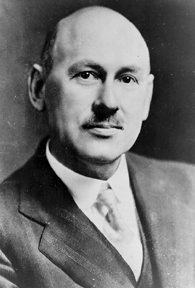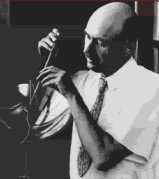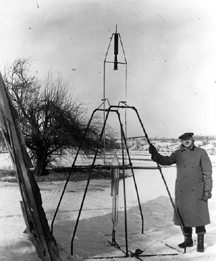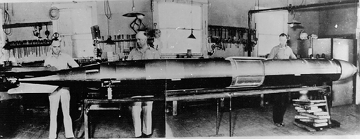- NASA Home
- | Centers
- | Goddard Home
- | About
About Goddard
Dr. Robert H. Goddard: American Rocket Pioneer
12.01.04
Major Contributions by Goddard
Historic Firsts
Historic Firsts for the Center
Biography of Dr. Robert H. Goddard
 "It is difficult to say what is impossible, for the dream of yesterday is the hope of today and the reality of tomorrow--Robert H. Goddard." Photo of Dr. Robert H. Goddard, Rocket Pioneer for whom the Goddard Space Flight Center is named courtesy of Mrs. Robert Goddard.
"It is difficult to say what is impossible, for the dream of yesterday is the hope of today and the reality of tomorrow--Robert H. Goddard." Photo of Dr. Robert H. Goddard, Rocket Pioneer for whom the Goddard Space Flight Center is named courtesy of Mrs. Robert Goddard.The father of modern rocket propulsion is the American, Dr. Robert Hutchings Goddard. Along with Konstantin Eduordovich Tsiolkovsky of Russia and Hermann Oberth of Germany, Goddard envisioned the exploration of space. A physicist of great insight, Goddard also had an unique genius for invention.
By 1926, Goddard had constructed and tested successfully the first rocket using liquid fuel. Indeed, the flight of Goddard's rocket on March 16,1926, at Auburn, Massachusetts, was a feat as epochal in history as that of the Wright brothers at Kitty Hawk. Yet, it was one of Goddard's "firsts" in the now booming significance of rocket propulsion in the fields of military missilery and the scientific exploration of space.
Primitive in their day as the achievement of the Wrights, Goddard's rockets made little impression upon government officials. Only through the modest subsidies of the Smithsonian Institution and the Daniel Guggenheim Foundation, as well as the leaves of absence granted him by Worcester Polytechnic Institute of Clark University, was Goddard able to sustain his lifetime of devoted research and testing. He worked for the U.S. Navy in both World Wars. Eighteen years after his successful demonstration at Auburn, Goddard's pioneering achievements came to life in the German V-2 ballistic missile.
Goddard first obtained public notice in 1907 in a cloud of smoke from a powder rocket fired in the basement of the physics building in Worcester Polytechnic Institute. School officials took an immediate interest in the work of student Goddard. They, to their credit, did not expel him. He thus began his lifetime of dedicated work.
 In 1914, Goddard received two U.S. patents. One was for a rocket using liquid fuel. The other was for a two or three stage rocket using solid fuel.
In 1914, Goddard received two U.S. patents. One was for a rocket using liquid fuel. The other was for a two or three stage rocket using solid fuel.At his own expense, he began to make systematic studies about propulsion provided by various types of gunpowder. His classic document was a study that he wrote in 1916 requesting funds of the Smithsonian Institution so that he could continue his research. This was later published along with his subsequent research and Navy work in a Smithsonian Miscellaneous Publication No. 2540 (January 1920). It was entitled "A Method of Reaching Extreme Altitudes." In this treatise, he detailed his search for methods of raising weather recording instruments higher than sounding balloons. In this search, as he related, he developed the mathematical theories of rocket propulsion.
Towards the end of his 1920 report, Goddard outlined the possibility of a rocket reaching the moon and exploding a load of flash powder there to mark its arrival. The bulk of his scientific report to the Smithsonian was a dry explanation of how he used the $5000 grant in his research. Yet, the press picked up Goddard' s scientific proposal about a rocket flight to the moon and erected a journalistic controversy concerning the feasibility of such a thing. Much ridicule came Goddard's way. And he reached firm convictions about the virtues of the press corps which he held for the rest of his life. Yet, several score of the 1750 copies of the 1920 Smithsonian report reached Europe. The German Rocket Society was formed in 1927, and the German Army began its rocket program in 1931. Goddard's greatest engineering contributions were made during his work in the 1920's and 1930's (see list of historic firsts). He received a total of $10,000 from the Smithsonian by 1927, and through the personal efforts of Charles A. Lindbergh, he subsequently received financial support from the Daniel and Florence Guggenheim Foundation. Progress on all of his work was published in "Liquid Propellant Rocket Development," which was published by the Smithsonian in 1936.
 Goddard's work largely anticipated in technical detail the later German V-2 missiles, including gyroscopic control, steering by means of vanes in the jet stream of the rocket motor, gimbal-steering, power-driven fuel pumps and other devices. His rocket flight in 1929 carried the first scientific payload, a barometer, and a camera. Goddard developed and demonstrated the basic idea of the "bazooka" two days before the Armistice in 1918 at the Aberdeen Proving Ground. His launching platform was a music rack. Dr. Clarence N. Hickman, a young Ph.D. from Clark University, worked with Goddard in 1918 and provided continuity to the research that produced the World War II bazooka. In World War II, Goddard again offered his services and was assigned by the U.S. Navy to the development of practical jet assisted takeoff (JATO) and liquid propellant rocket motors capable of variable thrust. In both areas, he was successful. He died on August 10, 1945, four days after the first atomic bomb was dropped on Japan.
Goddard's work largely anticipated in technical detail the later German V-2 missiles, including gyroscopic control, steering by means of vanes in the jet stream of the rocket motor, gimbal-steering, power-driven fuel pumps and other devices. His rocket flight in 1929 carried the first scientific payload, a barometer, and a camera. Goddard developed and demonstrated the basic idea of the "bazooka" two days before the Armistice in 1918 at the Aberdeen Proving Ground. His launching platform was a music rack. Dr. Clarence N. Hickman, a young Ph.D. from Clark University, worked with Goddard in 1918 and provided continuity to the research that produced the World War II bazooka. In World War II, Goddard again offered his services and was assigned by the U.S. Navy to the development of practical jet assisted takeoff (JATO) and liquid propellant rocket motors capable of variable thrust. In both areas, he was successful. He died on August 10, 1945, four days after the first atomic bomb was dropped on Japan.Goddard was the first scientist who not only realized the potentialities of missiles and space flight but also contributed directly in bringing them to practical realization. This rare talent in both creative science and practical engineering places Goddard well above the opposite numbers among the European rocket pioneers. The dedicated labors of this modest man went largely unrecognized in the United States until the dawn of what is now called the "space age." High honors and wide acclaim, belated but richly deserved, now come to the name of Robert H. Goddard.
On September 16, 1959, the 86th Congress authorized the issuance of a gold medal in the honor of Professor Robert H. Goddard.
In memory of the brilliant scientist, a major space science laboratory, NASA's Goddard Space Flight Center, Greenbelt, Maryland, was established on May 1, 1959.
Goddard's Major Contributions
Goddard's role as a leader in technology and science is as alive today as it was in 1959 when Explorer Vl, under Goddard project management, provided the world with its first image of Earth from space.
Goddard is the lead Center in NASA's Earth Science Enterprise (ESE), which is NASA's long term, coordinated researcheffort to study the Earth as a global environmental system. The Earth Observing System (EOS) is the centerpiece of the Enterprise and is managed by Goddard. EOS features a series of polar orbiting and low inclination satellites for global observations of the land surface, biosphere, solid Earth, atmospheres and oceans. The first EOS satellite, EOS Terra (formerly known as AM1), was launched in December 1999.
The end product of Earth Science Enterprise will be the ability to develop and implement environmental policies based on a better understanding of how our environment works. To develop that understanding, MTPE will rely on the EOS Data and Information System (EOSDIS). The EOSDIS has been designed to archive, manage and distribute MTPE data worldwide.
Goddard managed the highly successful first servicing mission of the Hubble Space Telescope (HST) in December 1993. The mission to correct the vision of the telescope's optical components, was described as the most challenging satellite servicing mission NASA has ever attempted. The 11 day mission included five days of astronaut spacewalks to service the telescope in space. The second HST servicing mission is scheduled for 1997. Goddard is also the home of the Space Telescope Operations Control Center (STOCC). The STOCC is the nerve center for HST where all commands for the telescope originate. From this location, project managers and engineers control the observatory, retrieve data, and maintain an around-the-clock vigil of HST. The health and safety of HST, efficient operation and flight system engineering of the observatory also are the responsibility of Goddard. The Space Telescope Science Institute, a user facility where the scientific observing program is formulated on behalf of the astronomical community, is likewise managed by Goddard.
Goddard is also responsible for the procurement, development and verification testing of the Geostationary Operational Environmental Satellite (GOES). GOES is a geostationary weather satellite system developed and launched by NASA for the National Oceanic and Atmospheric Administration (NOAA). The latest and most sophisticated satellite, GOES-L (11), was launched in May 2000. GOES provides atmospheric image, temperature and humidity profile, wind velocity data and severe storm coverage of the Earth's western hemisphere. NASA and NOAA are in a cooperative program to continue the GOES system with the launch of new generation GOES spacecraft throughout the decade.
Historic Firsts
Robert H. Goddard's basic contribution to missilery and space flight is a lengthy list. As such, it is an eloquent testimonial to his lifetime of work in establishing and demonstrating the fundamental principles of rocket propulsion.
- First explored mathematically the practicality of using rocket propulsion to reach high altitudes and even the moon (1912);
- First proved, by actual static test, that a rocket will work in a vacuum, that it needs no air to push against;
- First developed and shot a liquid fuel rocket, March 16, 1926;
- First shot a scientific payload (barometer and camera) in a rocket flight (1929, Auburn, Massachusetts);
- First used vanes in the rocket motor blast for guidance (1932, New Mexico);
- First developed gyro control apparatus for rocket flight (1932, New Mexico);
- First received U.S. patent in idea of multi-stage rocket (1914);
- First developed pumps suitable for rocket fuels;
- First launched successfully a rocket with a motor pivoted on gimbals under the influence of a gyro mechanism (1937).

Image above: Construction of the rocket used in the flight of April 19, 1932.
First for the Goddard Space Flight Center are listed below:
- First Earth photo from satellite. (Vanguard II)
- First successful weather satellite. (TIROS I)
- First passive communications satellite. (Echo I)
- First Earth-orbiting spacecraft launched by an all-solid rocket. (Explorer 9, Scout rocket)
- First privately-built communications satellite. (Telstar I)
- First international satellite. (Ariel 1)
- First geosynchronous communications satellite. (Syncom I)
- First operational trans-Atlantic communications satellite, for Comsat Corp. (Intelsat I)
- First satellite launch from mobile sea-based platform. (San Marco II)
- First gravity gradient satellite control system. (ATS II)
- First pictures of the Sun in UV wavelengths. (OSO-IV)
- First X-ray satellite. (Explorer 42)
- First geostationary weather satellite. (SMS A)
- First Earth Resources Technology (remote sensing- Landsat) satellite. (ERTS A)
- Pioneered Get-Away Special low-cost Shuttle experiment concept. (STS-4 1982)
- First satellite repaired in space. (SMM 1984)
- First space-based observations of ozone layer/hole. (Nimbus 7)
- Pioneered satellite-based tracking and data relay system. (TDRSS)
- First satellite to observe cosmic background radiation from early universe. (confirm big bang theory) (COBE)
- Pioneered SMEX satellite concept
- First image of the global biosphere, to include ocean phytoplankton and land vegetation. (SeaWifs 1998)
- First celestial survey in the Extreme Ultraviolet portion of the spectrum. (EUVE)
- First satellite to explore very rapid changes in x-rays from pulsars to black holes. (RXTE)
- First use of satellite tracking data to improve our knowledge of Earth's gravity field, learning we have a pear shaped world. (Minitrack on Vanguard l)
- First transfer of a liquid cryogen in space. (SHOOT, 1993, demonstrated the feasibility of on-orbit replenishment of stored cryogens such as liquid oxygen)
- First measurement of the global ozone amount from space. (BUV, Nimbus)
- First measurements of aerosols from space. (TOMS, 1979)
- First detection of volcanic SO2 from space. (El Chichon, TOMS, 1982)
- First space mission dedicated to observing and understanding tropical rainfall, more than 2/3's of all rainfall on Earth. (TRMM)
- First three axis stabilized Geostationary Weather satellite. (GOES l)
- First to use a Lagrangian point orbit: the International Sun-EarthExplorer-3 halo orbit about the L1 Lagrangian point of the sun-earth system (1978). The SOHO and ACE spacecraft are currently using such orbits.
- First spacecraft to encounter a comet: the International Cometary Explorer intercepted Comet Giacobini-Zinner on September 11, 1985, following a lunar-swingby within 80 miles of the lunar surface.
- First observations of the Earth’s magnetic fields.
- First electrically neutralized spacecraft (POLAR) equipped to observe the Earth’s polar cap and lobe plasma environments.
- First spacecraft (POLAR) making simultaneous images of the earth’s auroral zones.
- ATS-6 provided first satellite communications with aircraft. (PLACE experiment).
- ATS-6 provided first satellite television communications for teaching college courses.
- ATS-6 provided first satellite television communications for medical treatment in remote locations. (medical treatment of Eskimos in Alaska)
- ATS-3 demonstrated first satellite supported communications with ships at sea. (GE experiments with ships).
- The first satellite to provide everyday coverage of Earth’s radiation environment for more than 25 years. (IMP 8)
- First satellite in lunar orbit. (Explore 35).
- First radio astronomy spacecraft. (RAE).
- Largest antenna erected in space, 460 meters tip-to-tip. (RAE).
- First use of multiple spacecraft to track solar disturbances traveling through interplanetary space. (ISEE-3, Ulysses, WIND).
- First measurement of water vapor, Ethane and Methane, in comets. (with NASA's Kuiper Airborne Observatory and Infrared Telescope Facility on Mauna Kea, HI).
- Discovery of x-ray Emission from Comets (with ROSAT and EUVE satellites)
- First circumnavigation of Antarctica by a balloon in January 1989.
- First use of the internet for real-time science data operations which occurred during the first encounter of a comet by ISEE-3/ICE. (Sept. 1985)
- First images of host galaxies ray bursts. (Hubble Space Telescope/STIS)
- First in-orbit repair of an astronomical optical system. (Hubble Space Telescope)
- First observation of the eerie ultraviolet light from Earth’s upper atmosphere. (Sounding Rocket)
- First ultraviolet images of galaxies. (sounding rocket)
- First space observatory for use by all astronomers. (IUE)
- First extremely sharp extreme ultraviolet image of the solar corona. (TRACE)
- First spacecraft to make comprehensive measurements of the Earth’s environment of particles, fields and radiation. (OGO I)
- First spacecraft to explore the boundary of Earth’s magnetosphere. (Explorer X)
- First spacecraft to explore the Earth’s bow shock in the solar wind. (IMP 1)
- First test on ion drive in space. (ATS-6)
- First global image of the Earth’s biosphere that includes ocean phytoplankton and land vegetation (SeaWiFS 1998)
- First spacecraft over 35,000 pounds to be taken to space by the space shuttle. (Compton Ray Observatory)
- Nimbus 7: First imagery of the surface of the earth though clouds. (Nimbus 7 SMMR)
- Nimbus 7: First all-weather observations of the amount of sea ice on the polar oceans on a regular basis. This is one of the most reliable indicators of climate change, and will permit us to determine whether or not the climate is warming, cooling, or merely oscillating with a long-term period. (SMMR)
- First tracking and data relay constellation developed and launched by Goddard
- First spacecraft stationed in a libration-point orbit. (International Sun-Earth Explorer-3/ISEE-3)
- First real-time warning system for geomagnetic storms. (ISEE-3)
- First use of multiple lunar swingbys for orbital control in the Earth-Moon System. (ISEE-3)
- First encounter with a comet. (ISEE-3)